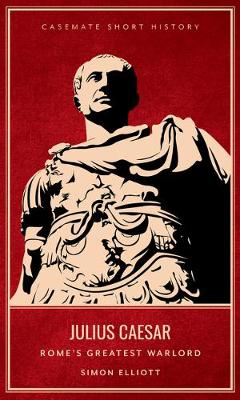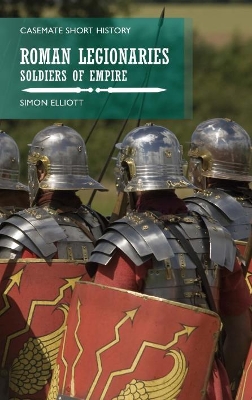Casemate Short History
3 total works
Julius Caesar has been the inspiration to countless military commanders over the last two millennia. Born into an aristocratic family, his early military campaigns, part of his progression along the cursus honorum, included campaigning in the east, Spain and in the early Roman civil wars. His participation in the Gallic Wars is known mainly through the commentary on the wars that he wrote and published, along with his incursions into Britain. This concise history details his military life, and how it impacted with his political career, from his youth through the civil wars that resulted in his becoming the dictator of Rome, and his legacy.
The age of the biblical warrior was one of both great technological development and innovation in warfare, and clashes between competing cultures in the ancient Middle East. The Sumerians were the first to introduce the use of bronze into warfare, and were centuries ahead of the Egyptians in the use of the wheel. The Assyrians developed chariot warfare and set the standard for a new equine-based military culture. The Babylonians had an army whose people were granted land in return for army service.
Beginning in approximately 3000 BC with the Sumerians, this authoritative short history gives a masterly overview of warfare and fighting in the age of the Old Testament, including Akkadians, Early and Middle Kingdom Egypt and their enemies, Mycenean and Minoan Greece and Crete (including Homer), Assyrians and New Kingdom Egyptians, the Hittites, the Sea Peoples who gave rise to the Philistines, the Hebrew kingdom, the Babylonian kingdom, the Medes and later Persian Empires, finishing with Dark Age and early Classical Greece.
Simon Elliott explains what light archaeology can shed on events in the Bible such as the famous 'walls came tumbling down' in the battle of Jericho, David the boy warrior who later faced the Philistines in two crucial battles, and Gideon whose military skills enabled him to defeat an army that vastly outnumbered his own. He also elucidates facts that still have resonance today, for instance the Philistines were originally the Peleset, who settled in Palestine. Peleset evolved to Philistine to Palestine today.
Beginning in approximately 3000 BC with the Sumerians, this authoritative short history gives a masterly overview of warfare and fighting in the age of the Old Testament, including Akkadians, Early and Middle Kingdom Egypt and their enemies, Mycenean and Minoan Greece and Crete (including Homer), Assyrians and New Kingdom Egyptians, the Hittites, the Sea Peoples who gave rise to the Philistines, the Hebrew kingdom, the Babylonian kingdom, the Medes and later Persian Empires, finishing with Dark Age and early Classical Greece.
Simon Elliott explains what light archaeology can shed on events in the Bible such as the famous 'walls came tumbling down' in the battle of Jericho, David the boy warrior who later faced the Philistines in two crucial battles, and Gideon whose military skills enabled him to defeat an army that vastly outnumbered his own. He also elucidates facts that still have resonance today, for instance the Philistines were originally the Peleset, who settled in Palestine. Peleset evolved to Philistine to Palestine today.
The might of Rome rested on the back of its legions; the superbly trained and equipped fighting force with which the imperial Roman army conquered, subdued and ruled an empire for centuries. The legionary soldier served for 20 years, was rigorously trained, highly equipped, and motivated by pay, bonuses and a strong sense of identity and camaraderie. Legionaries wore full body-armour, carried a shield which could be used defensively to form a shield wall or a tortoise, or it could be used offensively to punch at opponents and throw them off-balance in close-quarters fighting, as well as two javelins, a sword, and a dagger. In battle they hurled their javelins and then immediately drew their swords and charged to close combat with the enemy. They were the finest heavy infantrymen of antiquity, and a massed legionary charge was a fearsome sight.
Many legionaries had rural backgrounds; they were considered hardy with higher levels of endurance. This was needed to cope with incredibly tough training, during which recruits had to march first 29 km in five hours, and then 35 km in five hours with faster steps – all the while carrying a backpack that weighed over 20 kg. The slower ones were severely beaten by centurions and officers with their staffs. They were drilled in battlefield maneuvers, signaling and weapons handling, with faux swords and shields that were twice as heavy as the real ones, to acclimatize them to the exhaustion that could happen in the heat of battle.
This concise and entertaining history of the Roman legionary covers their history from the age of Augustus through the heyday of the Roman Empire. Topics include training, tactics, weapons, the men themselves, life on and off the battlefield as well as significant triumphs and disasters in the great battles of the era.
Many legionaries had rural backgrounds; they were considered hardy with higher levels of endurance. This was needed to cope with incredibly tough training, during which recruits had to march first 29 km in five hours, and then 35 km in five hours with faster steps – all the while carrying a backpack that weighed over 20 kg. The slower ones were severely beaten by centurions and officers with their staffs. They were drilled in battlefield maneuvers, signaling and weapons handling, with faux swords and shields that were twice as heavy as the real ones, to acclimatize them to the exhaustion that could happen in the heat of battle.
This concise and entertaining history of the Roman legionary covers their history from the age of Augustus through the heyday of the Roman Empire. Topics include training, tactics, weapons, the men themselves, life on and off the battlefield as well as significant triumphs and disasters in the great battles of the era.


